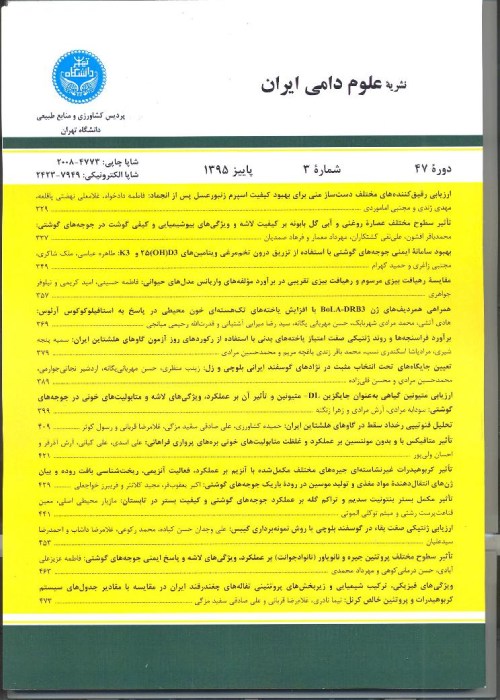A Study of The Effect of Individual and Family Selection on the Increase Body and Breast Weights in Japanese Quail
Author(s):
Abstract:
The current study was conducted to investigate the effect of short-term selection in Japanese quail for its 4-week body and breast weights. Two selected lines, one for selection of body weight based upon in. breeding values (line 1) and another for breast weight based on between family selections (line 2) were randomly selected from a base population. In each generation, 39 sire and 78 dam-birds were taken as parents in each line and for the next generation. The number of selected replacements in line 2 was less due to decreasing population size. Data were collected over 2 consecutive hatches for 4 generations and selections responses determined for 3 generations. The levels of improvement of 4-week body weights in line 1 were recorded 14.4, 12.6 and 8.1 grams respectively for the 3 generations. Correlated response to breast weight in line 1 was 4.1, 3.6, and 3.2 grams in generations 2, 3, and 4, respectively. Directed selection from 4-week breast weight in line 2 led to improvements of: 4.0, 3.5 and 2.7 grams in generations 2, 3 and 4, respectively. Also, correlated responses for body weight in this line were recorded as: 14.5, 13.0 and 7.4 grams in generations 2, 3 and 4, respectively. There were significant differences in body weight and carcass traits between sexes and also in generations 2 and upward (P<0.01) but not for percentage components of carcass. Higher figures were obtained for femals than for males. Selection for 4-week body weights in line 1 and 4-week breast weights in line 2 improved Feed Conversion Ratios (FCR) for about 0.16 and 0.19 units over the selected periods, respectively. Genetic and phenotypic correlations between body and breast weights in line 1 were 0.90±0.12 and 0.73±0.06 and for line 2 they were: 0.85±0.06 and 0.82±0.02, respectively. Results obtained from this study do not support the in-between family selection as a tool to increase breast weight selection as based on body weight, due to its high genetic correlation with body weight (0.85-0.90), can be employed as a proper selection criterion for improving carcass traits, including breast weight.
Keywords:
Language:
Persian
Published:
Iranian Journal of Animal Science, Volume:43 Issue: 4, 2013
Page:
531
magiran.com/p1110375
دانلود و مطالعه متن این مقاله با یکی از روشهای زیر امکان پذیر است:
اشتراک شخصی
با عضویت و پرداخت آنلاین حق اشتراک یکساله به مبلغ 1,390,000ريال میتوانید 70 عنوان مطلب دانلود کنید!
اشتراک سازمانی
به کتابخانه دانشگاه یا محل کار خود پیشنهاد کنید تا اشتراک سازمانی این پایگاه را برای دسترسی نامحدود همه کاربران به متن مطالب تهیه نمایند!
توجه!
- حق عضویت دریافتی صرف حمایت از نشریات عضو و نگهداری، تکمیل و توسعه مگیران میشود.
- پرداخت حق اشتراک و دانلود مقالات اجازه بازنشر آن در سایر رسانههای چاپی و دیجیتال را به کاربر نمیدهد.
In order to view content subscription is required
Personal subscription
Subscribe magiran.com for 70 € euros via PayPal and download 70 articles during a year.
Organization subscription
Please contact us to subscribe your university or library for unlimited access!


